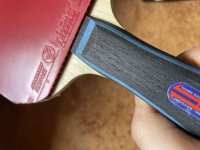This user has no status.
Member
There was some discussion in the Qatar 2018 thread on what Calderano should do to become a serious threat to the "big" Chinese players, like e.g. https://www.tabletennisdaily.com/forum/showthread.php?t=17250 - and the main theme was about how the elite non-Chinese should train more among themselves to improve. Initially this post was planned as a rant against the idea of such a stupid elitist club, and how instead to compete against the world dominator you need a solid foundation and big pool of people. More homegrown Kilian Ort's who made it to the German national finals and plays with Darko Jogic who last year took down Dima.
Talent is in abundance, so what makes the difference?
For me in a sense Dima and Calderano have some special or extra dedication to the sport. Sure all pro's work hard, but these two have some extra eagerness. But determination alone does not make you succeed. So what's the secret sauce?
In the TTD podcast with Prause he was talking about the Chinese secret of their success and how he was kind of disappointed to discover it was just hard, hard work.
While there is probably some truth to it, there is also this messy psychological side of professional TT. Like LGL recounts how from that first (?) ZJK game on international stage where he played very poorly but still fought it through, he knew that ZJK had it in him. Fang Bo or LGY on the other hand seem to be considered a bit to "soft" sometimes.
Hope it doesn't sound like kitchen sink psychology, but somehow I think the hardships in the earlier stages of ZJK an ML careers let them mature to the champions they became.
If Dima and Calderano are not up for more, Harimoto will probably be the most advanced persistent threat (APT) to CNT. Let's see.
Sent from my ZTE Grand S II LTE using Tapatalk
Talent is in abundance, so what makes the difference?
For me in a sense Dima and Calderano have some special or extra dedication to the sport. Sure all pro's work hard, but these two have some extra eagerness. But determination alone does not make you succeed. So what's the secret sauce?
In the TTD podcast with Prause he was talking about the Chinese secret of their success and how he was kind of disappointed to discover it was just hard, hard work.
While there is probably some truth to it, there is also this messy psychological side of professional TT. Like LGL recounts how from that first (?) ZJK game on international stage where he played very poorly but still fought it through, he knew that ZJK had it in him. Fang Bo or LGY on the other hand seem to be considered a bit to "soft" sometimes.
Hope it doesn't sound like kitchen sink psychology, but somehow I think the hardships in the earlier stages of ZJK an ML careers let them mature to the champions they became.
If Dima and Calderano are not up for more, Harimoto will probably be the most advanced persistent threat (APT) to CNT. Let's see.
Sent from my ZTE Grand S II LTE using Tapatalk














